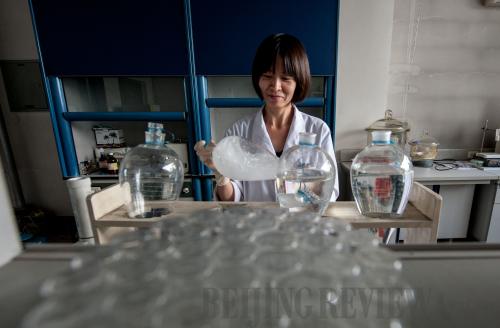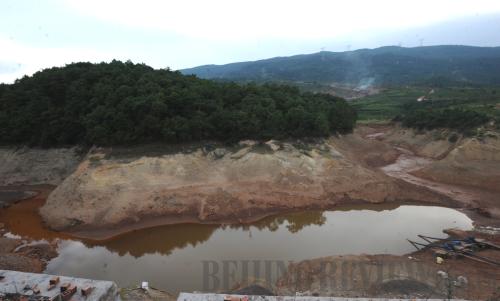|
 |
|
NEW STANDARDS: Water samples are examined in the Beijing Waterworks Group according to the new national standards for drinking water quality effective on July 1 (ZHANG YU) |
 |
|
SEVERE POLLUTION: Chromium-contaminated water in Chachong Reservoir in Qujing City, Yunnan Province, on August 14, 2011, which was polluted by Luliang Chemical Co. Ltd., a local producer of chromium sulfate (CHEN HAINING) |
Thanks to the long-awaited 17-billion-yuan ($2.67 billion) Qingcaosha Reservoir project, 11 million Shanghai residents now can drink water from the Yangtze River instead of the Huangpu River, which has been proven insufficiently pure. The new reservoir was finally put into use on June 8, 2011.
The reservoir was appointed to be the next resource for fresh water in Shanghai in 2006. Located on the mouth of the Yangtze River, its potability is rated class two according to national standards for surface water quality issued by the Ministry of Environmental Protection (MOEP) and the General Administration of Quality Supervision, Inspection and Quarantine in 2002. Class one is the highest.
However, the rating was questioned last August after Economy and Nation Weekly revealed that some cities excluded certain chemical elements from water quality tests in order to meet the standards.
"Taking Qingcaosha for example, nitrogen and phosphorus were not included in testing the water, even though the two elements are known for spawning algae that can severely contaminate water supplies," reported the leading Chinese weekly. "If these two elements are taken into consideration, the water quality of Qingcaosha will fall to the class-five level."
Shanghai's water authorities denied the accusation, saying that the nitrogen and phosphorus levels in the Qingcaosha Reservoir are controllable and the impurities are easily diluted due to water flow.
Not all the cities can be as lucky as Shanghai with its backup reservoir. There are only 10 provinces in China that have abundant water and more than 60 percent are in great demand of water. A survey conducted by the MOEP in 2010 showed that among 314 big and medium-sized cities in the country, 98 had no backup reservoirs and surface water was the only source of drinking water. Even for those with backup reservoirs, more than 50 percent could not reach even the lowest water-quality standards set by the MOEP.
In rural areas, conditions are much worse. Statistics from the MOEP show that by 2011, 323 million rural residents lacked clean drinking water, 34 percent of the whole rural population, and about 96 million people had no water utilities at all. Many villages have to exploit groundwater. At present, annual groundwater exploitation has reached 110 billion cubic meters, close to the warning limit of 123 billion cubic meters.
On June 29, the Chinese Government said that it would invest 175 billion yuan ($27.43 billion) before the end of 2015 to ensure safe drinking water in rural areas.
"Meanwhile, efforts should be made to protect water sources by reducing and optimizing the use of fertilizers and pesticides in agriculture, strengthening rural pollution treatment and water environment treatment, as well as boosting rural ecosystem restoration," said Li Guoying, Vice Minister of Water Resources.
| 